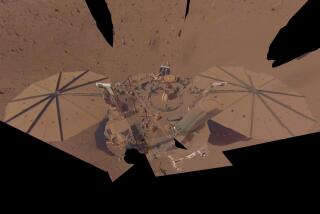Ice on the moon: Explorers may be able to raid ‘lunar freezer’
- Share via
Scientists believe that the glow from one extremely cold crater on the moon is due to ice, and now they are aglow too. What does moon ice mean for space exploration?
It could be a huge “lunar freezer,” acting as a source of water for a nearby lunar base. Think “man on the moon” -- but in a much more permanent way.
“Frozen water in particular could be a resource for future human explorers,” said Ashwin R. Vasavada, a planetary scientist for the Jet Propulsion Laboratory in La Cañada Flintridge, in an interview Thursday morning with the Los Angeles Times.
SPACE IMAGES: Mickey on Mercury and more
The Lunar Reconnaissance Orbiter was sent to the moon in 2009 with a mission of mapping its surface. Now it’s carrying out scientific experiments, as The Times’ Science Now blog reports, and topping that list was an effort to determine what was causing an unusual brightness in the south pole’s Shackleton crater.
As Vasavada noted, it’s long been theorized that the mountains near the moon’s poles could be places of permanent shadow, never feeling the touch of the sun.
“These super-cold places would be expected to trap water and other molecules that wander by,” he said, “like frost collecting on your roof on a cold morning.”
That trapped water would have its own story to tell -- as would other chemical compounds -- about the solar system, comets and asteroids, and how things have changed over time, the scientist said. So in itself, the ice is worth studying. Then there’s the issue of how it sparks visions of extended missions to the moon.
The moon’s deeply cold spots are sometimes adjacent to areas that catch the sun nearly all the time -- which makes them hot spots for a potential lunar base.
But Vasavada cautioned not to moon-leap too far with the orbiter’s findings.
“The discoveries ... show us that the temperatures are right, and the surfaces are bright as if covered by frost,” he said. “But we can’t say for sure that abundant ice is present.
“It’s exciting, though. The moon still surprises us.”
ALSO:
Firefighters hampered by meteors
A fiery meteor wows Oklahoma and Texas
Summer solstice 2012: Did you miss the longest day of the year?
Join Amy on Google+. Email: amy.hubbard@latimes.com
More to Read
Sign up for Essential California
The most important California stories and recommendations in your inbox every morning.
You may occasionally receive promotional content from the Los Angeles Times.











